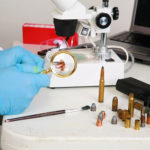
The very mention of x-rays would bring to mind their application as a diagnostic tool in hospital and dental clinics. However, x-rays find a vast range of other applications in diverse areas which will be covered briefly in the article.
What are x-rays?
X-rays constitute a small fragment of the electromagnetic spectrum having wavelengths ranging from 0.01 to 10 nm. This region falls between gamma and UV regions. In other words their wavelength is longer than gamma rays but smaller than UV rays. Depending on their energy levels x-rays are classified as hard x-rays with energies ranging from 5eV to 10keVand soft x-rays with energies in the range of 100eV to 5keV.
X-rays have a unique property of penetrating seemingly opaque objects such as tissue but are absorbed by bones and other metallic objects which serves to make them a useful diagnostic tool in medical applications.
Discovery of x-rays
Wilhelm Conrad Roentgen of Germany is credited with the discovery of x-rays in 1895. He observed a strange fluorescence glow on some crystalline material kept near a cathode ray tube. The glow persisted even when the crystals were covered with a dark paper. The unknown radiation emerging from the cathode ray tube was termed x-rays by Roentgen as x is commonly used alphabet for an unknown factor in mathematics. Roentgen was awarded the Nobel Prize in physics for this discovery in 1901.
Applications of X-Rays
Medical diagnosis
X-rays can penetrate soft tissues but not bones or other foreign objects embedded in the body. This feature is put to use with for diagnosis of own bone fractures and deformities, foreign bodies deformities and tumor growths. The photographic plates also called radiograms and provide useful information for treatment of such conditions. X-rays can damage healthy tissue so excessive exposure should be avoided by using protective shields.
Industrial applications
X-rays find several applications in nondestructive testing for cracks and fatigue in manufactured components. X-ray lithography uses precise X-ray beams to embed miniature circuit patterns on silicon chips.
Radiation therapy
High energy x-ray beams are used for destruction of cancerous cells. However, as the beams do not differentiate between normal and cancerous cells their use requires monitoring by medical experts.
Baggage security
Baggage materials like leather and plastics are transparent to x-rays but concealed guns and knives made of metal are opaque to them. This feature serves as a quick means for screening of baggage by security personnel at airports and railway stations.
Structural arrangement of atoms and molecules
X-rays have found use in study of crystal geometries and polymorphism in materials. This is possible because the wavelength range of x-rays is similar to size of atoms in such substances. Both Single crystal and Powder systems are available for such studies and there are several commercial manufacturers to provide such instruments.
Astronomical research
X-rays are also present in interstellar space. Main sources being neutron stars and black holes at centre of spiral galaxies which gobble up stellar matter in their neighborhood and in the process emit x-rays. Based on such phenomena astronomers have postulated studies on origins of the universe. Typically such studies are conducted with the help of orbiting telescopes.




